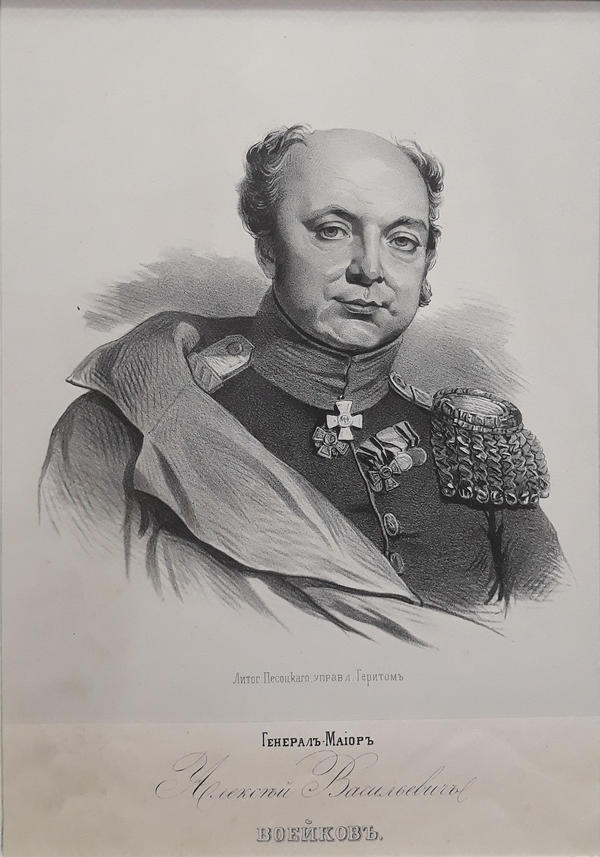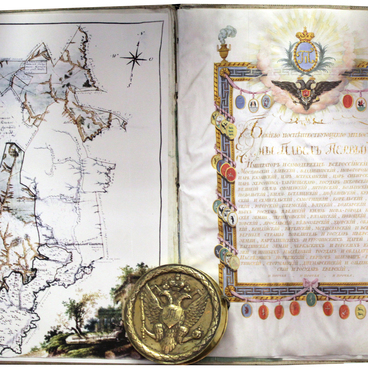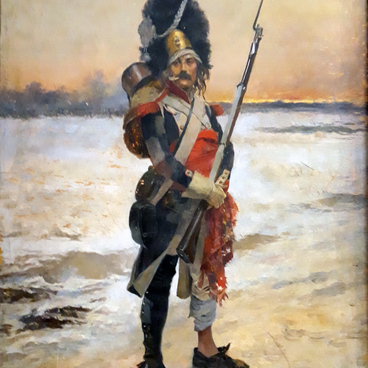This print made by an unknown master depicts a portrait of Maj.-Gen. Alexei Voeykov, a nobleman originating from the Oryol Governorate. The work was executed by chisel: The master cut a mirror-image of the drawing on a metal plate, and then printed the portrait on paper. The year of this picture has not been established.
Voeykov was born in 1778. He graduated from a university boarding school for boys in Moscow in 1796. A year later, he was made warrant officer and began active military service. He was Alexander Suvorov’s orderly during the Swiss Expedition. Afterwards, during the Finnish War of 1808—1809, Voeykov met military commander Michael Andreas Barclay de Tolly and became friends with him. At the time, Voeykov translated fiction and articles, wrote poetry (classical and sentimental odes, love lyrics).
In 1810, Barclay de Tolly was appointed War Minister. Voeykov, who was a colonel, became aide-de-camp and, by virtue of that rank, part of His Imperial Majesty’s entourage. Officers of the emperor’s entourage performed special orders and wore the monarch’s monogram on their epaulets or shoulder straps. In the same year, Voeykov received a position in the Special Chancellery of the War Minister and de facto became head of the Russian military intelligence.
A year later, Voeykov was appointed to another office — in the commission for the drafting of military regulations. In that capacity, he got acquainted with Mikhail Speransky, a reformer and lawmaker. When Speransky fell into disgrace with the emperor and was exiled, Col. Voeykov, as his associate, was discharged from the ministry (he was not, however, stripped of his rank as aide-de-camp) and dispatched to the infantry regiment of Lieutenant-General Borozdin. He was put in charge of the Third Brigade of the 27th Infantry Division that consisted of new recruits. In a short while, Voeykov managed to train them into proper soldiers, but, by 1813, the strength of the brigade had dwindled more than by half.
Voeykov took part in the Battle of Krasnoi, the Battle of Borodino and the Battle of Maloyaroslavets. In the Battle of Borodino, Voeykov’s brigade was defending the Semyonovsky Flèches, i.e. an outwork shaped like an arrowhead (flèche in French) or an acute angle; this type of fieldwork was usually built to protect important parts of the front. The French were unable to push Russian troops fully from the village of Semyonovsky until the very end of the battle. Voeykov distinguished himself in action and was promoted to the rank of major general.
In 1813–1814, Voeykov took part in the Foreign Campaign of the Russian army, in hostilities in the Duchy of Warsaw and in Silesia. Near Kaiserwald, his arm was seriously wounded. After the war, the Major General retired and went to his estate of Olshanka near Tambov. Alexei Voeykov died in 1825, and was buried in the Tregulyay St. John the Baptist Monastery near Tambov.
Voeykov was born in 1778. He graduated from a university boarding school for boys in Moscow in 1796. A year later, he was made warrant officer and began active military service. He was Alexander Suvorov’s orderly during the Swiss Expedition. Afterwards, during the Finnish War of 1808—1809, Voeykov met military commander Michael Andreas Barclay de Tolly and became friends with him. At the time, Voeykov translated fiction and articles, wrote poetry (classical and sentimental odes, love lyrics).
In 1810, Barclay de Tolly was appointed War Minister. Voeykov, who was a colonel, became aide-de-camp and, by virtue of that rank, part of His Imperial Majesty’s entourage. Officers of the emperor’s entourage performed special orders and wore the monarch’s monogram on their epaulets or shoulder straps. In the same year, Voeykov received a position in the Special Chancellery of the War Minister and de facto became head of the Russian military intelligence.
A year later, Voeykov was appointed to another office — in the commission for the drafting of military regulations. In that capacity, he got acquainted with Mikhail Speransky, a reformer and lawmaker. When Speransky fell into disgrace with the emperor and was exiled, Col. Voeykov, as his associate, was discharged from the ministry (he was not, however, stripped of his rank as aide-de-camp) and dispatched to the infantry regiment of Lieutenant-General Borozdin. He was put in charge of the Third Brigade of the 27th Infantry Division that consisted of new recruits. In a short while, Voeykov managed to train them into proper soldiers, but, by 1813, the strength of the brigade had dwindled more than by half.
Voeykov took part in the Battle of Krasnoi, the Battle of Borodino and the Battle of Maloyaroslavets. In the Battle of Borodino, Voeykov’s brigade was defending the Semyonovsky Flèches, i.e. an outwork shaped like an arrowhead (flèche in French) or an acute angle; this type of fieldwork was usually built to protect important parts of the front. The French were unable to push Russian troops fully from the village of Semyonovsky until the very end of the battle. Voeykov distinguished himself in action and was promoted to the rank of major general.
In 1813–1814, Voeykov took part in the Foreign Campaign of the Russian army, in hostilities in the Duchy of Warsaw and in Silesia. Near Kaiserwald, his arm was seriously wounded. After the war, the Major General retired and went to his estate of Olshanka near Tambov. Alexei Voeykov died in 1825, and was buried in the Tregulyay St. John the Baptist Monastery near Tambov.



